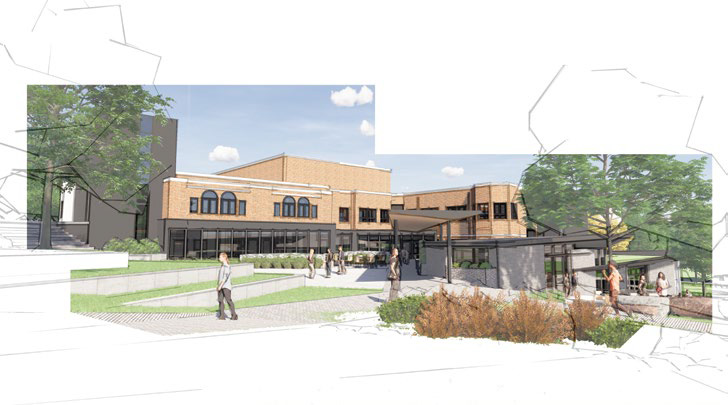“When the new Upper School opens,” says Head of School Bryan Garman, “it will mark a reshaping not just of our physical campus, but of the learning environment for Sidwell Friends students and faculty.”
Thoughtfully, ethically, and sustainably designed, the new Upper School will add six contiguous acres to the Sidwell Friends School’s Washington, DC, campus. The last major acquisition of adjoining property was nearly 70 years ago—Zartman House and the athletic fields—and it transformed the School we know today. Now, following a rare opportunity to purchase adjacent land, the School is once again poised for incredible transformation. Donors like Cathy Ritzenberg McCulloch ’68 and her husband Scot McCulloch ’64 helped make this once-in-a-generation opportunity possible by supporting the real estate purchase.
From the start, the brick-and-mortar project has incorporated environmental and social responsibility goals. The new Upper School building is expected to conserve and creatively reuse fully 80 percent of the site’s existing structure.
Spanning 131,500 square feet over three floors, the new building also embraces Quaker aesthetics of simplicity and integrity in design and materials. For well-being and optimal learning, building priorities include maximizing natural light, outdoor views, air quality, and acoustics standards. Use of native flora and green roofs will bring a sense of serenity, simplicity, and reflection with access to nature every day. Flexibility is also key to allow for continual adaptation to new teaching and learning models over time.
“Ultimately, of course, learning at Sidwell Friends is about the teachers and the students,” says Associate Head of School Min Kim. “But there is a lot of power in creating a conducive learning environment, one that is light-filled and with student wellness in mind.” As an example, she says, the robotics lab will move from its current basement room to a bright, flexible space that can maximize interaction and collaboration. “Students will also have access to a variety of outdoor learning spaces,” says Kim. “Places for quiet reflection will be built into the campus design to foster and nurture spiritual and mental wellness as well as academic and intellectual growth.”
Multi-use spaces for collaboration, hands-on projects, and greater creativity will open pathways for new excellence. In addition to the extraordinary robotics lab, there will be new science and independent research areas that reflect best practices in higher education, a reimagined library that will improve research and scholarship opportunities, as well as a whole new approach to bringing nature into the classroom and taking learning outdoors.
“We envision using School gardens to learn about biology and the building’s sustainability elements for an environmental science class,” says Assistant Upper School Principal for Academic Affairs Robert Gross. “Our physics, engineering, and robotics teachers are really excited about what they are going to be able to do in the new space.”

More open spaces such as the new Fox Den and cafeteria will also allow for greater interaction between faculty and students. “We want teachers to be running into students and having serendipitous conversations so that the work from classrooms can continue,” says Garman. We also want students to have places to gather to talk and to be themselves. Upper School Principal Mamadou Guèye agrees: “If you want to build a community, you need those spaces where people can caucus and be friendly and joke and really know each other.”
Donors to the Together We Shine campaign, including alumni, parents, grandparents, and multiple family members, are making the new Upper School possible. “I have utilized, throughout my life, what I learned at Sidwell academically and what I learned from the Quaker experiences and philosophy,” says Frank Gunion ’67. “I believe it was a vital part of my business success, my volunteer work in education and the environment, and for creating a meaningful family life.” Frank and his brother, John Gunion ’61, have funded a student breakout space in the new building.
“The influence of surroundings is a critical part of the developing mind,” says Frank, whose mother was a Sidwell Friends student and whose grandmother taught with Thomas Sidwell.
With each generation, the Sidwell Friends community has sought to prepare its students for new challenges, always expanding the idea of what students need to know. And donors like the Gunions, the McCullochs, and so many more have been inspired to help. Min Kim says that there is a tremendous sense of urgency to reimagine the future of learning in this particular moment. “We are sending our children out into the world to face challenges that are greater than those faced by any other generation—economic instability, climate change, pandemics, war. As a Quaker school, it’s our responsibility to equip our students to face these challenges, not only with technical knowledge and creative problem-solving skills, but also with a deep understanding of how to build relationships and community, to promote peace, to strive for the greater good of all humans—that is the reason behind all of this.”


